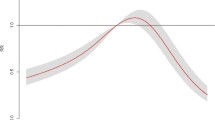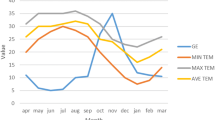Abstract
Local climatic factors might explain seasonal patterns of rotavirus infections, but few models have been proposed to determine the effects of weather conditions on rotavirus activity. Here, we study the association of meteorologic factors with rotavirus activity, as determined by the number of children hospitalized for rotavirus gastroenteritis on the Mediterranean island of Mallorca (Spain). We conducted a retrospective review of the medical records of children aged 0–5 years admitted for rotavirus gastroenteritis between January 2000 and December 2010. The number of rotavirus hospitalizations was correlated to temperature, humidity, rainfall, atmospheric pressure, water vapor pressure, wind speed, and solar radiation using regression and time-series techniques. A total of 311 patients were hospitalized for rotavirus gastroenteritis in the 11-year study period, with a seasonal pattern from December to June, and a peak incidence in February. After multiple regressions, weekly rotavirus activity could be explained in 82 % of cases (p < 0.001) with a one-week lag meteorologic model. Rotavirus activity was negatively associated to temperature and positively associated to atmospheric pressure, solar radiation, and wind speed. Temperature and solar radiation were the factors that contributed most to the model, with a peak rotavirus activity at 9 °C and 800 10KJ/m2, respectively. In conclusion, hospitalization for rotavirus was strongly associated with mean temperature, but an association of rotavirus activity with solar radiation, atmospheric pressure, and wind speed was also demonstrated. This model predicted more than 80 % of rotavirus hospitalizations.




Similar content being viewed by others
References
Cook SM, Glass RI, LeBaron CW, Ho MS (1990) Global seasonality of rotavirus infections. Bull World Health Organ 68:171–177
Brandt CD, Kim HW, Rodriguez WJ, Arrobio JO, Jeffries BC, Parrott RH (1982) Rotavirus gastroenteritis and weather. J Clin Microbiol 16:478–482
Levy K, Hubbard AE, Eisenberg JNS (2009) Seasonality of rotavirus disease in the tropics: a systematic review and meta-analysis. Int J Epidemiol 38:1487–1496
D’Souza RM, Hall G, Becker NG (2008) Climatic factors associated with hospitalizations for rotavirus diarrhoea in children under 5 years of age. Epidemiol Infect 136:56–64
Hashizume M, Armstrong B, Wagatsuma Y, Faruque AS, Hayashi T, Sack DA (2008) Rotavirus infections and climate variability in Dhaka, Bangladesh: a time-series analysis. Epidemiol Infect 136:1281–1289
Atchison CJ, Tam CC, Hajat S, van Pelt W, Cowden JM, Lopman BA (2010) Temperature-dependent transmission of rotavirus in Great Britain and The Netherlands. Proc Biol Sci 277:933–942
Patel MM, Pitzer VE, Alonso WJ, Vera D, Lopman B, Tate J, Viboud C, Parashar UD (2013) Global seasonality of rotavirus disease. Pediatr Infect Dis J 32:e134–e147
Ansari SA, Springthorpe VS, Sattar SA (1991) Survival and vehicular spread of human rotaviruses: possible relation to seasonality of outbreaks. Rev Infect Dis 13:448–461
Zhaori GT, Fu LT, Xu YH, Guo YR, Peng ZJ, Shan WS (1991) Detection of rotavirus antigen in tracheal aspirates of infants and children with pneumonia. Chin Med J (Engl) 104:830–833
Purohit SG, Kelkar SD, Simha VK (1998) Time series analysis of patients with rotavirus diarrhoea in Pune, India. J Diarrhoeal Dis Res 16:74–83
Norval M (2006) The effect of ultraviolet radiation on human viral infections. Photochem Photobiol 82:1495–1504
Norval M, Garssen J, Van Loveren H, el-Ghorr AA (1999) UV-induced changes in the immune response to microbial infections in human subjects and animal models. J Epidemiol 9:S84–S92
Wilkinson RJ, Llewelyn M, Toossi Z, Patel P, Pasvol G, Lalvani A, Wright D, Latif M, Davidson RN (2000) Influence of vitamin D deficiency and vitamin D receptor polymorphisms on tuberculosis among Gujarati Asians in west London: a case–control study. Lancet 355:618–621
Schwarz A, Navid F, Sparwasser T, Clausen BE, Schwarz T (2012) 1,25-dihydroxyvitamin D exerts similar immunosuppressive effects as UVR but is dispensable for local UVR-induced immunosuppression. J Invest Dermatol 132:2762–2769
Leung KH (1989) Inhibition of human natural killer cell and lymphokine-activated killer cell cytotoxicity and differentiation by vitamin D3. Scand J Immunol 30:199–208
Yasukawa M, Nakagomi O, Kobayashi Y (1990) Rotavirus induces proliferative response and augments non-specific cytotoxic activity of lymphocytes in humans. Clin Exp Immunol 80:49–55
Mori I, Matsumoto K, Sugimoto K, Kimura M, Daimon N, Yokochi T, Kimura Y (2002) Prolonged shedding of rotavirus in a geriatric inpatient. J Med Virol 67:613–615
Dennehy PH (2000) Transmission of rotavirus and other enteric pathogens in the home. Pediatr Infect Dis J 19(10 Suppl):S103–S105
Sattar SA, Lloyd-Evans N, Springthorpe VS, Nair RC (1986) Institutional outbreaks of rotavirus diarrhoea: potential role of fomites and environmental surfaces as vehicles for virus transmission. J Hyg (Lond) 96:277–289
Fischer TK, Steinsland H, Valentiner-Branth P (2002) Rotavirus particles can survive storage in ambient tropical temperatures for more than 2 months. J Clin Microbiol 40:4763–4764
Parashar UD, Gibson CJ, Bresee JS, Glass RI (2006) Rotavirus and severe childhood diarrhea. Emerg Infect Dis 12:304–306
Bishop RF (1996) Natural history of human rotavirus infection. Arch Virol Suppl 12:119–128
Sumi A, Rajendran K, Ramamurthy T, Krishnan T, Nair GB, Harigane K, Kobayashi N (2013) Effect of temperature, relative humidity and rainfall on rotavirus infections in Kolkata, India. Epidemiol Infect 141:1652–1661
García-Basteiro AL, Bosch A, Sicuri E, Bayas JM, Trilla A, Hayes EB (2011) Hospitalizations due to rotavirus gastroenteritis in Catalonia, Spain, 2003–2008. BMC Res Notes 20(4):429. doi:10.1186/1756-0500-4-429
Conflict of interest
The authors have no conflicts of interest to declare.
Author information
Authors and Affiliations
Corresponding author
Rights and permissions
About this article
Cite this article
Hervás, D., Hervás-Masip, J., Rosell, A. et al. Are hospitalizations for rotavirus gastroenteritis associated with meteorologic factors?. Eur J Clin Microbiol Infect Dis 33, 1547–1553 (2014). https://doi.org/10.1007/s10096-014-2106-y
Received:
Accepted:
Published:
Issue Date:
DOI: https://doi.org/10.1007/s10096-014-2106-y




